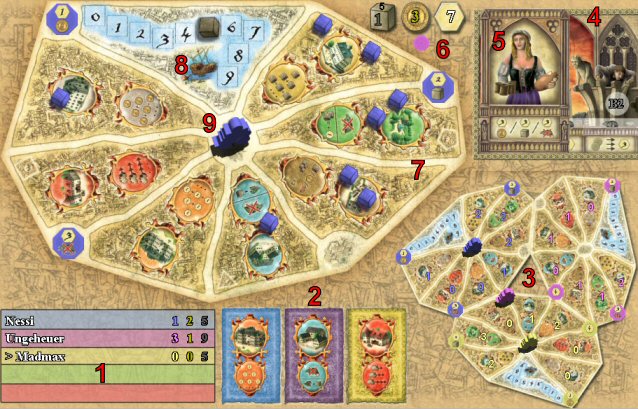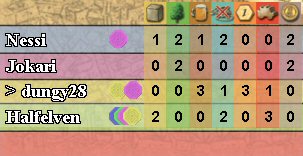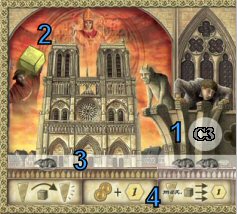Notre Dame
NotreDame (Originalregel)
Preparazione del gioco
Con /join possono giocare da 2 a 5 giocatori. Con/startinizia la partita. Alternatively, you can use the gioco tool.
The gioco
Notre Dame is ambient a Parigi nel XIV secolo. I have great importance in the area of the city, even if there is a problem with the important personality of the city. This guide mainly explains the online operation and does not claim to be complete. The complete rules can be downloaded from the publisher's website as a pdf file.
Tavolo di gioco
 < div class="clear">
< div class="clear">- Stato dei giocatori
- Carte azione
- Piano di gioco completo < li>Notre Dame
- Carte personalità
- Dotazione
- Il tuo distretto (se si fa passare il mouse su un altro distretto nella mappa completa, thiso verrà visualizzato in questa posizione)
- Porto con indicatore dei ratti
- Carrozza

< span>Accanto ai nomi dei giocatori è indicato the attack of the denaro, the cubetti influenza and the position of the contactor of ratti di ciascun giocatore. If you have the mouse on the main map (in basso a destra), you can see the composition of the gettoni messaggio presi, come the repartizione of the cubetti influenza nel loro distretto.

A sinistra di Notre Dame è rappresentata the dotazione di cubetti influenza (nell'esempio 1 = riserva personale, 5 = riserva generale), the money of gold, oltre ai punti influenza raccolti. When the messages are recuperated, these are the indicators.

- Indicatore di turno : the letter (da A a C) indicates the advance, the number (as 1 to 3) indicates the turn of all the internal tales.
- Cubetti influenza in Notre Dame < li>Bordo dei Ratti: numero totale dei ratti delle tre carte personalità
- Per vedere l'intera carta personalità passare il mouse sulla sezione corrispondente.
Preparazione del gioco
In funzione del numero di giocatori vengono piazzati three, quattro or cinque distretti.
Ad inizio partita ogni giocatore riceve:
- 4 cubetti influenza
- 1 fiduciario < li>1 Carrozza
- 3 pezzi d'oro
- 9 Carte Azione
4 gettoni messaggio vengono distribuiti casualmente nel distretto del giocatore .
Svolgimento
La partita consists of 3 advances: one advance and the compost of 3 turns, each turn containing 5 fasi .
- Pescare delle carte personalità
- Scegliere le carte azione
- Giocare delle carte azione
- Corrompere una personalità
- Calcolo della eventualità di peste
Stage 1 - Pesca delle carde Personalità
In this case the tipi of the personal card: 6 chestnuts and 9 grigies.
All'inizio di ciascun turno vengono pescate 2 delle 6 carte personalità chestnuts. This card can be used in a voltage per advance and, in a voltage that is used, is available for the prossimo.
The Grays reveal one card per round; Here the three A cards come into play first, then the three B cards and finally the three C cards (see explanation of the Person cards). These cards only appear once in the game.
Dunque per ogni turno sono available 2 cards marroni and 1 grigia.
Fase 2 - Scelta delle Carte Azione
Ogni giocatore pesca the prime three carte del proprio mazzo. You can see and pass the other due to the sinistra victim.

Selezionare the due carte che volete passare e cliccate sull'icona 'passa carte'.
Delle due carte che ricevete dal vicino di destra ne viene scelta una e viene passata a sinistra l'altra. In this case there are 3 cards for the game.
The appointments of the advanced players also receive the card of the proprio color and the rimescola.
Fase 3 - Giocare carte azione
Ogni giocatore ha a questo punto 3 carte azione che giocare durante this phase. Per giocare una carta click sopra la carta stessa. The effect is on the map of the corresponding correspondence. Successful in proprio turno ognuno gioca una seconda carda zione. The terza carta viene scartata (nascosta).
The individual action cards are explained in more detail in the Appendix.
I have influenza in the piazzare nel distretto possono essere presi dalla propria riserva. If you don't have these cubes in the system, you can select a cube that is present in a zone and send the new position to the card. It's all possible to use the story.

You don't have to use/send a cube to start the game. Per far ciò cliccare sulla X rossa della carta.
Fase 4 - Corrompere una personalità
Giocate the carte azione, orgni giocatore può a turno corrompere - al prezzo di pezzo d'oro - una ed una sola personalità estratta durante la phase 1. Si utilizza dunque l 'abilità della personalità. For personal information click on the corresponding card.

If you don't have personal information, you can pass it.< /span>
A person may also be bribed by several players. The characteristics of the 15 people are explained here.
Calcolo della eventualità di peste
Well the epidemic value is determined. To do this, all rats on the three face-up person cards are added together and each player's rat stone is moved forward on their harbor track by the same number of spaces.
Se sono presenti cubetti influenza nell'Ospedale, tale quantità viene scalata dal numero dei ratti in arrivo. If the difference is negative, the contact of the rats is still indie, but may come from the zero.
Se the contact of the rats supera il 9 accade quanto segue:
- Il giocatore perde 2 punti prestigio

- Viene Rimosso un cubeto influenza dalla zone più popolosa e messo nella riserva generale. A parità di popolazione, the giocatore sceglie da quale zone perdere il cubetto.
- Il contatore dei ratti viene messo a 9
Valutazione di Notre Dame
Old dates of the other advances (alla fine di ogni 3 turns), i cubetti influenza in Notre Dame vengono ricompensati come segue:
In functionzione del numero di giocatori, Notre Dame vale 6/8/10/12 punto per rispettivamente 2/3/4 /5 giocatori. The value is appropriate for the total number of influenza present in Notre Dame, arranged by the difetto necessary. Tutti i giocatori che hanno cubetti a Notre Dame ricevono punti in funzione della propria percentuale di cubetti influenza.
I cubetti influenza tornano nella riserva generale.
Fine del gioco
The dates of the three advances (nove turni) are the gioco termina dopo the terza valutazione di Notre Dame. Vince is the giocatore with the maggior numero di punti prestigio. A parità vince il giocatore with the maggior somma di pezzi d'oro / cubetti influenza nella riserva personale.
Regole speciali per il gioco in due
In a part of the 2nd, the map can be used for the part of 4, so there are 6 points for Notre Dame in 10th. I gettoni messaggio vengonono posti in tutti e quattro i distretti e, per poter pescare ancora un gettone dello stesso colore, occorre aver pescato prima quelli di tutti i colori.
Durante lo scambio The carte azione in phase 2, ogni giocatore seleziona 2 carte da passare, poi ancora una, e si recupera dunque una delle due carte passate in precedenza.
A parte questo le regole sono invariate.

